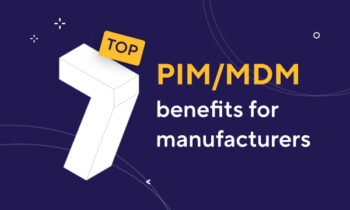Top 3 tips before launching your PIM or MDM project

Launching a PIM (Product Information Management) or MDM (Master Data Management) project can be complex. For over 20 years, we’ve been helping companies in their digital transformation. That’s why our experts have put together their top 3 tips to ensure your project runs smoothly!
Implementing a PIM, and even more so an MDM, will revolutionize your company’s organization.
Identifying the potential pitfalls or risks of such a project is not easy. DATASOLUTION supports you in the preparation and design phases, so you can achieve your strategic objectives and succeed in your digital transformation for marketing.
Before sharing our tips to apply at the start of a PIM or MDM project, let’s go over the difference between these two concepts.
PIM versus MDM : what’s the difference?
Definition of PIM (Product Information Management)
A PIM solution coordinates the management and multichannel distribution of product data to various platforms, including e-commerce websites, printed product catalogs, and marketplaces.
It helps harmonize product information, ensuring that all content is up to date and SEO-friendly across channels. This makes PIM a key tool for companies managing large product catalogs across multiple sales channels.
PIM is essential for businesses in retail and manufacturing, especially those handling thousands of product references. It also forms part of the broader MDM framework.
Definition of MDM (Master Data Management)
MDM (Master Data Management) refers to a set of tools that store, manage, and distribute reference data — including product information, customer data, supplier data, and digital assets — within an organization.
By centralizing data into a single repository, MDM helps simplify a company’s internal processes. It ensures that reference data is reliable and of high quality, promoting effective data governance across departments.
Pimcore : the open-source MDM solution
Pimcore is the only open-source MDM solution at an enterprise level. Its open and flexible model allows businesses to create and manage custom objects, including customers, suppliers, or product lines.
Additionally, its built-in DAM (Digital Asset Management) helps businesses organize and manage digital assets effectively.
As a strategic partner since 2018, Datasolution assists clients in integrating Pimcore into their existing IT ecosystems.
Maps: at the core of data governance
Since 2011, Maps has been providing clients with comprehensive PIM, MDM, and DAM solutions to manage both strategic and operational data.
This allows companies to focus on their core business and growth, knowing that their data is reliable and well-governed.
As a champion partner of Maps, Datasolution supports clients in implementing this complete data repository solution.
3 tips before launching a PIM or MDM project
1. Involve your teams from the very start of the project
When an IT department (DSI) initiates a PIM or MDM project on its own, there can be a disconnect between business users’ needs and the final solution. It’s essential to involve your teams right from the beginning to ensure you capture their valuable insights and everyday challenges. Otherwise, you risk developing a marketing production platform that lacks key features required by business users.
To gather meaningful contributions from your teams, follow these 3 steps:
- At the start of the project, bring together the main departments involved to identify their challenges. Datasolution organizes workshops with your marketing and communication teams to help them express their needs and prioritize them.
- During the requirement gathering and design phases, encourage collaboration between departments and ensure that key users work directly with project managers. This way, critical business functionalities won’t be overlooked.
- Throughout the project, schedule regular feedback sessions. Using an agile Scrum methodology, as we do at Datasolution, helps you create and refine the project roadmap (product backlog). With each iteration, you’ll build a solution that best meets your needs and those of your users.
By involving key users from the beginning, you’ll save time, achieve a faster return on investment (ROI), and gain better team buy-in — all critical for change management, which is essential to your project’s success.
2. Prepare your strategic data and your teams
Many companies underestimate the work required to prepare data for PIM or MDM integration. Our experts at Datasolution assist you in organizing and structuring your data to ensure optimal data quality.
In addition to data preparation, it’s crucial to prepare your project team.
We recommend defining the following roles within your team:
- The project sponsor
- The product manager
- Key users or team leads
Make sure your project team includes a good mix of business expertise and management skills.
Without proper preparation, you risk delays or budget overruns. When the team is well-prepared and aligned, the next project phases become much smoother.
3. Have a clear vision and goals
You need to ask yourself the following questions:
- How will we define the success of the project after its implementation?
- What is our main objective in implementing a PIM or MDM solution?
Are we aiming for better data quality? Unifying marketing data? Improving user experience? Boosting organizational efficiency? Achieving more agility to scale? Or perhaps diversifying into new distribution channels or markets?
Finding the answers to these questions — and reaching something close to a consensus — will surely set your project on the path to success.
In conclusion…
DATASOLUTION supports you in defining your objectives and selecting the most suitable solution to achieve them. Our industry experts will provide recommendations to engage your entire team throughout the project lifecycle, from organization to methodology, including technological choices.
Need help framing your PIM or MDM project? Contact our experts!


